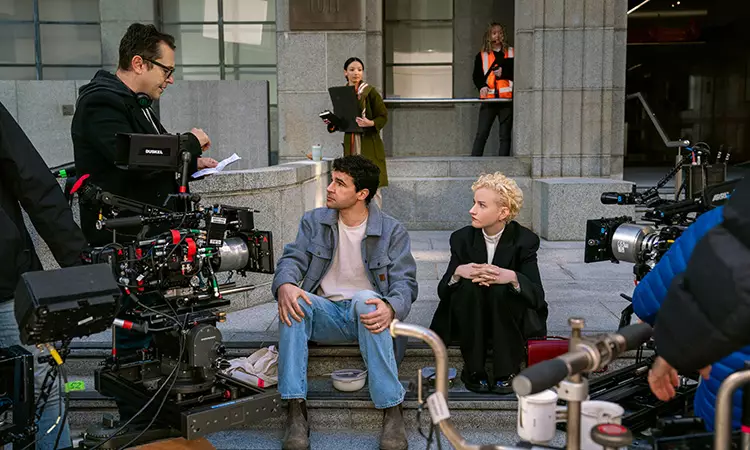Leigh Whannell, known for his innovative approach in “The Invisible Man,” has reimagined another classic monster for contemporary audiences with “Wolf Man.” This latest installment in Universal’s monster legacy explores themes that resonate deeply in today’s world. The film follows Blake, a man grappling with the mysteries of his past and the complexities of his family life. As he inherits a remote farmhouse from his missing father, the story unfolds with a blend of familial strain and supernatural suspense. Whannell’s decision to weave intricate family dynamics into the narrative elevates “Wolf Man” from mere horror to a poignant study of relationships under siege.
As audiences will see, Blake’s decision to take a break from city life with his high-powered wife, Charlotte, and their young daughter, Ginger, introduces an underlying tension. His motivations to escape into the past—one marred by familial loss—reflect modern-day struggles of many families; the need for connection amidst chaos. The approach resonates particularly well during an era characterized by a shared sense of isolation, enforced by the COVID-19 pandemic. In this modern setting, the monstrous threats outside of the farmhouse become almost secondary to the psychological transformations occurring within its walls.
In interviews, Whannell expressed how he had to cultivate a passion for the film that went beyond the mere allure of adapting a famous character. His vision was not only to create a horror movie but to transform it into an emotional experience that captures the essence of familial disintegration. The filmmaker’s intent was clear: “I wanted it to be really emotional… a real family story about these relationships disintegrating.” This introspective approach signifies a departure from conventional monster narratives, opting for a focus on human vulnerability.
Whannell’s commitment to authenticity shines through, especially during the writing process, which coincided with a period of heightened anxieties regarding personal safety and family welfare. The chaotic emotions stemming from living in lockdown, coupled with parenthood fears, influenced the rawness of the script. This transformative personal experience added layers to the characters’ struggles, making them relatable and significant in today’s cultural landscape.
One of Whannell’s ingenious decisions is his exploration of the balance between fear and visibility. Unlike many horror films that rely heavily on visual spectacles, “Wolf Man” emphasizes a different kind of terror—one that stems from the unknown and the unexpected changes in Blake. As the family seeks refuge inside their farmhouse, the line between predator and prey blurs. The invisible threat lurking outside paves the way for Blake’s own internal battle with transformation. He becomes a living embodiment of the monster, manifesting both physical and emotional metamorphosis.
This narrative structure supports Whannell’s intention to not merely recreate old tales but to reinvent them. By focusing on sensory details and sound design, he crafts an immersive atmosphere that relates more to the viewers’ personal fears and emotional experiences. The audience witnesses, alongside Charlotte, the devolution of a husband into a creature—an exploration of identity and the instinctual drive to protect loved ones against external threats.
The creative process for Whannell seems almost labyrinthine—an analogy he himself used. Writing “Wolf Man” became a journey through intricate twists and turns, filled with moments of inspiration and frustration. When crafting a narrative that flows seamlessly, Whannell acknowledges the challenge of navigating through plot developments without excessive lore. The goal is a tighter, more immediate experience. A single night of terror captures the essence of horror while maintaining a focus on relationships, resonating profoundly with audiences and reflecting real-life anxieties.
Ultimately, Whannell’s approach to the ending is noteworthy. Unlike many screenwriters who may lay the groundwork for sequels, he designed “Wolf Man” to stand alone, embodying a definitive period in the characters’ lives. His focus on crafting a satisfying conclusion underscores the importance of resolution in storytelling—an aspect often overlooked in franchise-centered narratives.
“Wolf Man” emerges as a revitalized portrayal of a classic horror figure, embodying contemporary fears and reflecting the intricate struggles of modern life. Whannell’s film is not just about the thrill of the chase or the horror of the unknown; it is a deep exploration of familial bonds, fears of disconnection, and personal metamorphosis. By striking a balance between the external and internal battles faced by the family, Whannell succeeds in crafting a narrative that is both terrifying and deeply human. As audiences venture into this psychological horror, they may find that the most chilling aspects are not merely the lurking beast outside, but the unraveling relationships within. Through “Wolf Man,” Whannell has indeed created a unique and resonant piece of cinema that solidifies his mark on the genre of horror.

